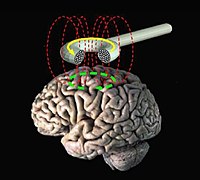
Photo from wikipedia
Objectives Patients with multiple sclerosis (PwMS) frequently suffer from psychiatric symptoms [2] . Anxiety and depression are among the most reported ones and could drastically affect patients’ quality of life… Click to show full abstract
Objectives Patients with multiple sclerosis (PwMS) frequently suffer from psychiatric symptoms [2] . Anxiety and depression are among the most reported ones and could drastically affect patients’ quality of life [2] . Understanding the underlying mechanisms of these symptoms might enable optimizing therapeutic strategies. The current study aims to assess the relationship between corticospinal excitability measures, anxiety and depression in PwMS. Methods PwMS were recruited from the neurology department of Henri Mondor Hospital. They filled the Hospital Anxiety and Depression Scale (HADS). The following measures were obtained using transcranial magnetic stimulation (TMS) [1] : resting motor threshold, short interval intracortical inhibition (interstimuli intervals [ISI]: 2 and 4 ms), intracortical facilitation (ISI: 10, 12 and 15 ms), interhemispheric inhibition (ISI: 8, 10 and 12 ms) and cortical silent period. Correlation analysis was applied to assess the relationship between HADS anxiety/depression scores and TMS measures. Results Fifty patients were enrolled. Their mean age was 51.82 ± 12.72 years. They had a mean anxiety score of 5.82 ± 3.42 and a mean depression score of 6.08 ± 3.66. Significant direct correlation was found between anxiety scores and interhemispheric inhibition (r = 0.43, P = 0.003). Depression scores did not correlate with any TMS measure. Conclusion To the best of our knowledge, this study is the first to address the neurophysiological correlates of psychiatric symptoms in PwMS. It highlights the relationship that would exist between anxiety scores and interhemispheric inhibition, the latter reflects the integrity of the transcallosal transfer. Such a relationship is in line with prior studies [3] and suggests that PwMS with higher anxiety scores may relatively have a more efficient callosal transfer than those with lower scores. Although interesting, this finding needs to be further addressed in future studies.
Journal Title: Neurophysiologie Clinique
Year Published: 2018
Link to full text (if available)
Share on Social Media: Sign Up to like & get
recommendations!